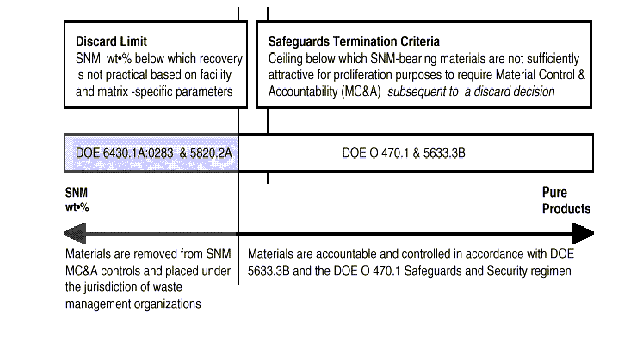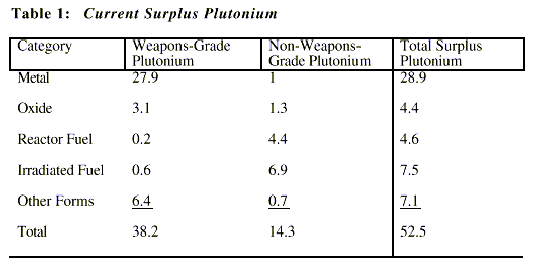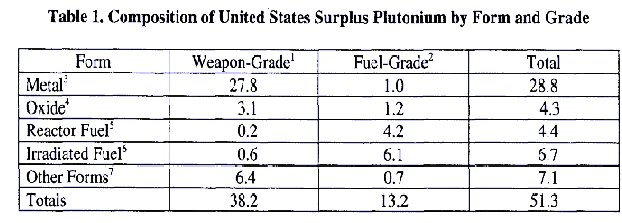|
Endnotes
i. For
in-depth overviews of plutonium and other special
nuclear materials, see:
iv. DoD Militarily Critical Technologies list. Nuclear Weapons Technology. Section 5. v. Lawrence Livermore National Laboratory. Stockpile Stewardship Program. UCRL-LR-129261. 9781 vi. Hecker, Sigfried. 2000. Los Alamos Science. Number 26, and Plutonium Aging: From Mystery to Enigma. LA-UR-99-5821. 1999. vii. Condit, R.H. 1993. Plutonium: An Introduction. Lawrence Livermore National Laboratory. UCRL-JC-115357. Prepared for submittal to the Plutonium Primer Workshop. DOE Office of Arms Control and Proliferation in Washington, D.C. on September 29, 1993. viii. U.S. DOE. Plutonium, the First Fifty Years; 1996; and Declassification of Plutonium Inventory at Rocky Flats, Colorado, 1994. ix. Radiation Effects in Plutonium. Los Alamos Science. Number 26. x. Ibid. xi. Ibid. xii. Haschke, John. 2000. The Surface Corrosion of Plutonium. Los Alamos Science. No. 26. xiii. Condit, R.H. 1993. Plutonium: An Introduction; and Plutonium Storage by John M. Haschke and Joseph C. Martz. xiv. LA-3542. Plutonium Processing at LANL. 1983. xv. Westinghouse Savannah River Company. 2000. Facility Design Description for Pit Disassembly and Conversion Facility. February 24, 2000. Page 55. xvi. Plutonium Processing at LANL . 1983. xvii. DOE Standard 3013. xviii. U.S. Department of Energy. Plutonium. The First 50 Years. DOE actually declared 99.5 MT but this did not include 0.1 MT of “classified transactions.” xix. Inventory Differences used to be called “Materials Unaccounted For” xx.Savannah River Site FY 2001 Annual Operating Plan. Summary Task Description Sheet. SOXX. MC&A. xxi. http://www.ieer.org xxii. This graphic illustrates the fine line between “waste” and “residues.” Historically much of what is now called “residues” would have been recovered by purifying the plutonium. Russia’s policy is to recover plutonium from all forms until there is less than 200 ppm of plutonium remaining. Only then does it become a waste.
Integrated Nuclear Materials Management Plan. June 2000.
xxxiv
xxxv. Olivas. Plutonium Aging. xxxvi. Letter, William D. Magwood, DOE, Office of Nuclear Energy, to Laura S. H. Holgate, DOE, Office of Fissile Materials Disposition, "Zero Power Physics Reactor (ZPPR) Plutonium Fuel," November 12, 1999. Referred to in the November 2000 SRS Pu Storage Plan. xxxvii. Design Only Conceptual Design Report for Plutonium Immobilization Plant. February 2000. Revision 1. xxxviii. Integrated Materials Plan. Page 2-4. xxxix. Gray, L.W. et al. 1999. The Blending Strategy for the Plutonium Immobilization Program. Paper prepared for submittal to the Waste Management ‘99 Symposium, Tuscon, Arizona. February 28-March 4, 1999. UCRL-JC-133279. Lawrence Livermore National Laboratory. xl xli. U.S. Atomic Energy Commission Nuclear Safety Working Group. 1956. A Preliminary Consideration of the Hazards of Sealed Pit Weapons. Sanitized Version from DOE Archives. xlii. Pantex was selected as the long-term storage (up to 50 years) facility for plutonium pits in the January 1997 Record of Decision for the Programmatic Environmental Impact Statement for Storage and Disposition of Weapons-Usable Fissile Materials; and under the Pantex Plant Sitewide Environmental Impact Statement (January 1997), up to 20,000 plutonium pits can be stored there. xliii. Pantex now claims that total pit numbers are classified. xliv. Mason and Hanger Corporation. 2000. Pantex Pit Management Plan. Final Revision 3. October 27, 2000. Pantex Nuclear Materials Department. Page 38. xlv. Ibid. Page 42. xlvi. Ibid. Page 43. xlvii. Toevs, 1997. LA-UR-97-4113. Surplus Weapons Plutonium: Technologies for Pit Disassembly and Conversion and MOX fuel Fabrication. . xlviii. xlix. Ibid. All pit type ID’s obtained from this source or otherwise noted. l. Rocky Flats Safety Analysis Report for the AL-R8 Container. 1990. li. Ibid. lii. Ibid. liii. Mason and Hanger Corporation. 2000. Pantex Pit Management Plan. liv. Institute for Energy and Environmental Research. Plutonium Fact Sheet. lv. Data Call for Stockpile Stewardship Management Programmatic Environmental Impact Statement. Los Alamos Plutonium Pit Production. 1995. lvi. Glasstone and Redman. An Introduction to Nuclear Weapons. June 1972. Atomic Energy Agency. Sanitized Version from DOE Archives. lvii. Westinghouse Savannah River Company. 2000. Facility Design Description for Pit Disassembly and Conversion Facility. February 24, 2000. Page 55. lviii. Glasstone and Redman. An Introduction to Nuclear Weapons. lix. LA-UR-00-504 January 2000 Safeguards and Security Program Quarterly Activity Summary October 1-December 31, 1999. lx. Ibid. lxi. Ibid. lxii. Wedman, Douglas E. and Steven D. McKee. Uranium Disposition Options for a Pit Disassembly Facility. LA-UR-00-128. February 200. lxiii. Ibid. lxiv. Glasstone and Redman. An Introduction to Nuclear Weapons. lxv. Mattingly, et al. 1998. Passive NMIS Measurements to Estimate the Shape of Plutonium Assemblies (Slide Presentation.) Y-12 Oak Ridge Plant. November 25, 1998. Y/LB-15,998. lxvi. Glasstone and Redman. An Introduction to Nuclear Weapons. lxvii. Minutes of Plutonium Information Meeting. Rocky Flats Plant. June 29-30, 1959. Issued August 7, 1959. DOE Archives. Sanitized Version. lxviii. Glasstone and Redman. An Introduction to Nuclear Weapons. lxix. Glasstone and Redman. An Introduction to Nuclear Weapons lxx. Westinghouse Savannah River Company. 2000. Facility Design Description for Pit Disassembly and Conversion Facility. February 24, 2000. Page 55. lxxi. Pit Resuse Station. 1993. lxxii. 3/26/99 letter from DOE to DNFSB: Classified Plutonium at Rocky Flats. lxxiii. Pits are “suspected to be clad with beryllium” in this report if they were separated from the high explosives using similar technologies as the W-48. lxxiv. Rocky Flats Safety Analysis Report for the AL-R8 Container. 1990. lxxv. Buntain, G., et al 1995. Pit Storage Monitoring. LA-12907 UC-721 April 1995. lxxvi. Dow, Jerry (LLNL) and Lou Salazar (LANL). Letter to Department of Energy. Re: Storage Facility Environmental Requirements for Pits and CSA’s. August 22, 1995. lxxvii. Defense Nuclear Facilities Safety Board. Pantex Plant Activity Report for Week Ending July 10, 1998. lxxviii. ARIES Source Term Fact Sheet (LALP-97-24, Rev. 3, April 24, 1998). lxxix. http://www.osti.gov/html/osti/opennet/document/rdd-1/drwcrtf3.html#ZZ1 lxxx. SPDEIS. Page 3-923. lxxxi. Los Alamos National Laboratory and Fluor Daniel, Inc. 1997. Design-Only Conceptual Design Report for the Pit Disassembly and Conversion Facility. Project No. 99-D-141. Prepared for the DOE Office of Fissile Materials Disposition. December 12, 1997. lxxxii. ARIES Source Term Fact Sheet (LALP-97-24, Rev. 3, April 24, 1998). lxxxiii. The tritium data was contained in Pit Disassembly and Conversion Facility EIS Data Report. LA-UR-97-2909. The Draft SPDEIS referred to this document on Page 3-4. lxxxiv. Tanksi, John A. 2000. A Model for the Initiation and Growth of Metal Hydride Corrosion. LA-UR-00-5496. 23rd DOE Aging, Compatibility, and Stockpile Stewardship Conference. November 14-16, 2000. lxxxv. http://www.osti.gov/html/osti/opennet/document/rdd-1/drwcrtf3.html#ZZ1 1) Fact that bonding of plutonium or enriched uranium to materials other than themselves is a weapon production process. (93-2) (2) Fact that such bonding occurs or may occur to specific unclassified tamper, alpha-barrier or fire resistant materials in unspecified pits or weapons. (93-2) (3) Fact that plutonium and uranium may be bonded to each other in unspecified pits or weapons. (93-2) (4) Fact that such bonding may be diffusion bonding accomplished in an autoclave or may be accomplished by sputtering. (93-2) (5) Fact that pit bonding/sputtering is done to ensure a more robust weapon or pit. (93-2) (6) The use of autoclaves in pit production. (93-2) (7) The fact that plutonium is processed in autoclaves. (93-2) (8) The fact that sputtering of fissile materials is done at or for any Department of Energy facility as a production process. (93-2) (9) The fact of a weapons interest in producing a metallurgical bond between beryllium and plutonium. (93-2) (10) The fact that beryllium and plutonium are bonded together in unspecified pits or weapons. (93-2) (11) Routine data concerning concentrations of beryllium in plutonium higher than 100 ppm. (93-2) lxxxvi. Kidinger, John, ARES Corporation, John Darby and Desmond Stack, Los Alamos National Laboratory. 1997. Technical Risk Assessment for the Department of Energy Pit Disassembly and Conversion Facility Final Report. September, 1997. LA-UR-97-2236. (TRA or Technical Assessment) lxxxvii. Toevs, 1997. LA-UR-97-4113. Surplus Weapons Plutonium: Technologies for Pit Disassembly and Conversion and MOX fuel Fabrication lxxxviii. Ibid. lxxxix. The list of problem pits, like the list of weapons with disassembly problems, seems to be dominated by LLNL designs. Three of the four pit types requiring cleaning are LLNL designs, as is the most problematic pit, the W-48. The only remaining weapons systems to dismantle under START I are LLNL designs-the W79, the W56, which have both been problematic programs. xc. Pantex Work Authorization Directives. Fiscal Year 2000. xci. Rocky Flats Safety Analysis Report for the AL-R8. 1990. xcii. Khalil, Nazir, Bill Bish, and Ken Franklin. 1998. Process development implementation plan for pits, LA-UR-98-5047. Page 2. xciii. Sun-Woo, A.J., M.A. Brooks, and J.E. Kervin. 1995. Characterization of Stainless Steel 304 Tubing. UCRL-ID-122234. October 16, 1995. xciv. Mason and Hanger Corporation. 2000. Pantex Pit Management Plan. xcv. Khail, et al. Process development implementation plan for pits. xcvi. Stockpile Stewardship Enhanced Surveillance Program. 1998. xcvii. The unclassified version of the report can be downloaded in the “Public Documents” section at http://www.dp.doe.gov. xcviii. Commission on Maintaining United States Nuclear Weapons Expertise. Report to the Congress and Secretary of Energy Pursuant to the National Defense Authorization Acts of 1997 and 1998. March 1, 1999 xcix. Savannah River Site Strategic Plan. http://www.srs.gov c. Ibid. ci. Rudisill, T.S. and M.L. Crowder. 1999. Characterization of d Phase Plutonium Metal WSRC-TR-99-00448. Westinghouse Savannah River Company cii. Ibid. ciii. Collins, Susan, and Henry Randolph. 1997. Gas Pycnometry for Density Determination of Plutonium Parts. Westinghouse Savannah River Company. WSRC-MS-97-00636. Document prepared for the 21st Aging, Compatibility, and Stockpile Stewardship Conference, Albuquerque, NM. 9/30/97 to 10/2/97. civ. Hart, Mark. M, Warren Wood, and J. David Olivas. Plutonioum Pit Manufacturing and Unit Process Separation Options for Rapid Reconstitution. A Joint Position Paper of LLNL and LANL. September 6, 1996. |



